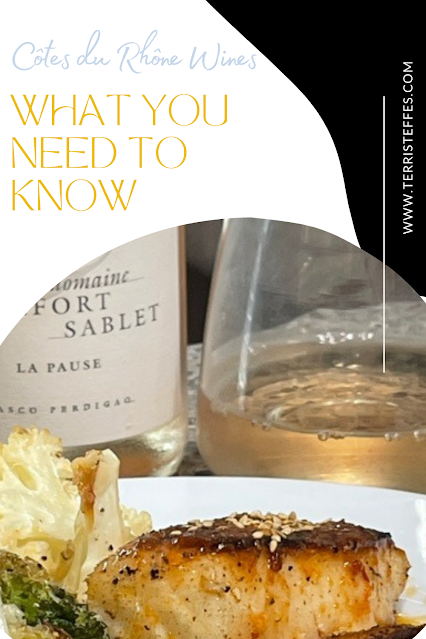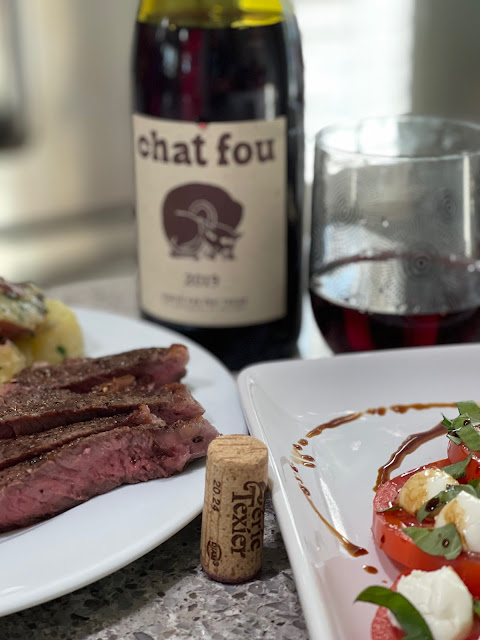#Winophiles are writing about all things Côtes du Rhône this month and since this was new to me, I wanted to explore what it is you needed to know about drinking wines from this area. What you need to know about Côtes du Rhône wine is written below.
Côtes du Rhône means "the hillsides of the river" and is an AOC (Appellation d'Origine Contrôlée) in France. It is one of the largest AOCs in France and one of the oldest, too. It is said that the vineyards were planted by the Greeks and the Romans in 125BC. Côtes du Rhône and Côtes du Rhône Villages produce about 40 million GALLONS of wine annually, with 21 varieties of grapes including Grenache, Mersanne, Roussanne, Viognier, Syrah, and Mourvedre.
Wines are impacted by what happened millions of years ago, so let's look at what was going on, about 300 million years back. Imagine this: volcanoes are erupting, producing granite rocks in the northern Rhone. Layers of sediment containing fluvial and calcareous marine sediments piled up in what is now known at the Dentelles de Montmirail. Then 40 million years back, the Alps pushed upwards, causing the valley to form and then flooded by the Mediterranean Sea. The Strait of Gibraltar closed and the Sea level went down exposing sands, clay, rock, limestone which flowed into the Rhone, making bedrock that plays a huge role in the way the wines of the Rhone smell and taste. Amazing, right?
So how about those Greeks and Romans? Evidence in the form of earthenware jars shows how long the area has been used for wine-making. In the 4th century BC, Romans sailed up the Rhone founded Vienne and planted vineyards. Much heavy labor was needed to build retaining walls for terraces and double-digging. The Roman Empire's collapse was a severe blow to the wine industry and it wasn't until the Middle Ages, with the influence of the Church did the area begin to flourish again.
 |
| Used with permission from Côtes du Rhône |
When wines from both sides of the river were being recognized for their quality, Baron Le Roy took aim at getting quality control measures brought to the area, and in 1933 the AOC was formed. It became the model for future AOCs which govern the growing area, varieties are grown, minimum alcohol content, and harvesting (plus much more.) He suggested the name Côtes du Rhône for its ancient name.
The area has had wonderful vintages for decades and you can read about them here. Each growing season (a vintage) has its particular mark on the wines, due to weather conditions and other factors. It is particularly interesting and exciting to get the year's report about the wines from the current season.
I was gifted six wines to try from the area and I want to share with you information from the distributors that sponsored us.
Domaine Chamfort La Pause Rosé 2020 Côtes du Rhône Villages Sablet AOCWine Description: La Pause is made from Grenache and Syrah are grown on terraced vineyards. This rosé is made in the saignée method
Tasting Notes: Crushed cherries, strawberries, and raspberries. Notes of orange zest and peach.
Pairings: grilled sausage, kabobs, grilled vegetables.
Domaine Gramenon La Sagesse Rouge 2019
Wine Description: Sourced from old-vine Grenache. After a manual harvest, the grapes are carefully sorted and then partially destemmed and macerated in concrete tanks for fifteen days. Slow, ambient fermentation is followed by twelve months in a combination of barrels and demi-muids and bottled without fining or filtration.
Tasting Notes: This luscious ruby-red wine exhibits the unbridled purity of fruit with aromas of crushed dark berries, plum, and a hint of savory smoke. On the palate, it is broad, generous, and complete, with beautiful balance and finesse.
Pairings: Roast chicken, pork, and game. Should be decanted.
Domaine Ogier Artesis Blanc 2018
Wine Description: A blend of Grenache Blanc, Clairette, Roussanne, and Viognier. After undergoing a gentle pressing, the grapes are slowly cool-fermented in order to preserve the aromatics and prevent malolactic fermentation. The wine is then rested on its lees for four months in concrete vats for the wine to achieve well-rounded richness.
Tasting Notes: Aromas of ripe summer peach, rose blossom, white pear, and a hint of marzipan and white pepper. On the palate, this wine delights with savory and herbal notes, along with vibrant acidity and well-rounded balance.
Pairings: Seafood and roast chicken
Éric Texier Chat Fou Rouge 2019
Wine Description:
Tasting Notes: Notes of red berries, fresh mint, sweet spices, and a minerality that continues to unfold well into the palate. Fresh and versatile,
Pairings: Chill, then serve with charcuterie, mezze platters, seafood.
Lavau La Décelle 2018
Wine Description: Made from equal parts Grenache and Syrah grown at an altitude of just over 1,000 feet above sea level, this wine showcases exceptional ripeness, freshness and levity. The grapes undergo a long 30-day period of maceration and fermentation. The wine is then aged for six months in second-passage French oak before bottling.
- Jeff from Food Wine Click! thinks we should Embrace the Base of the Côtes du Rhône Pyramid.
- Cindy of Grape Experiences suggests we Sip Wine from the Côtes-du-Rhône... then Visit the Rhône Valley.
- Cathie of Side Hustle Wino exclaims OMGigondas.
- Mel of Wining with Mel introduces us to The Wonderful World of Chapoutier in Côtes du Rhône.
- Terri of Our Good Life tells you What You Need to Know about Côtes du Rhône Wines.
- Camilla of Culinary Adventures with Camilla Assembles an End of Summer Cheeseboard with Domaine Chamfort Sablet La Pause Côtes du Rhône Villages 2019.
- Robin of Crushed Grapes Chronicles talks about Côtes du Rhône & Côtes du Rhône Villages – a plethora of flavors to pair with!
- David of Cooking Chat shares Grilled Sirloin Steak and Cotes du Rhone
- Jen of Vino Travels takes us on A Journey Through the Cotes du Rhone
- Jane of Always Ravenous shares Cote du Rhone Wines: Tasting and Pairing
- Nicole of Somm's Table says Bring on the Cotes du Rhone
- Katrina of The Corkscrew Concierge explains Why You Should be Drinking White Rhone Wines
- Linda of My Full Wine Glass introduces us to Red, white and pink-The colors of Cotes du Rhone wine
- Pinny of Chinese Food and Wine Pairings shares Cotes du Rhone and Perfect Fried Rice
- Jill of L'Occasion is Feeling Satisfied with Cotes du Rhone
- Susannah of Avvinare shares A Fresh Look at the Cote du Rhone
- Wendy from A Day in the Life on theFarm shares A month's worth of celebrations with Cotes du Rhone.















What a great history of the region! I was visualizing as I was reading. And the wines sound delicious!
ReplyDeleteHistorical geology is a tough subject for me to keep interesting, but you described it so well! Cheers!
ReplyDeleteSo many wonderful wines to work through! I loved the food-friendly La Pause Rosé. Bet it was yummy in that pairing. Is that grilled swordfish?
ReplyDelete